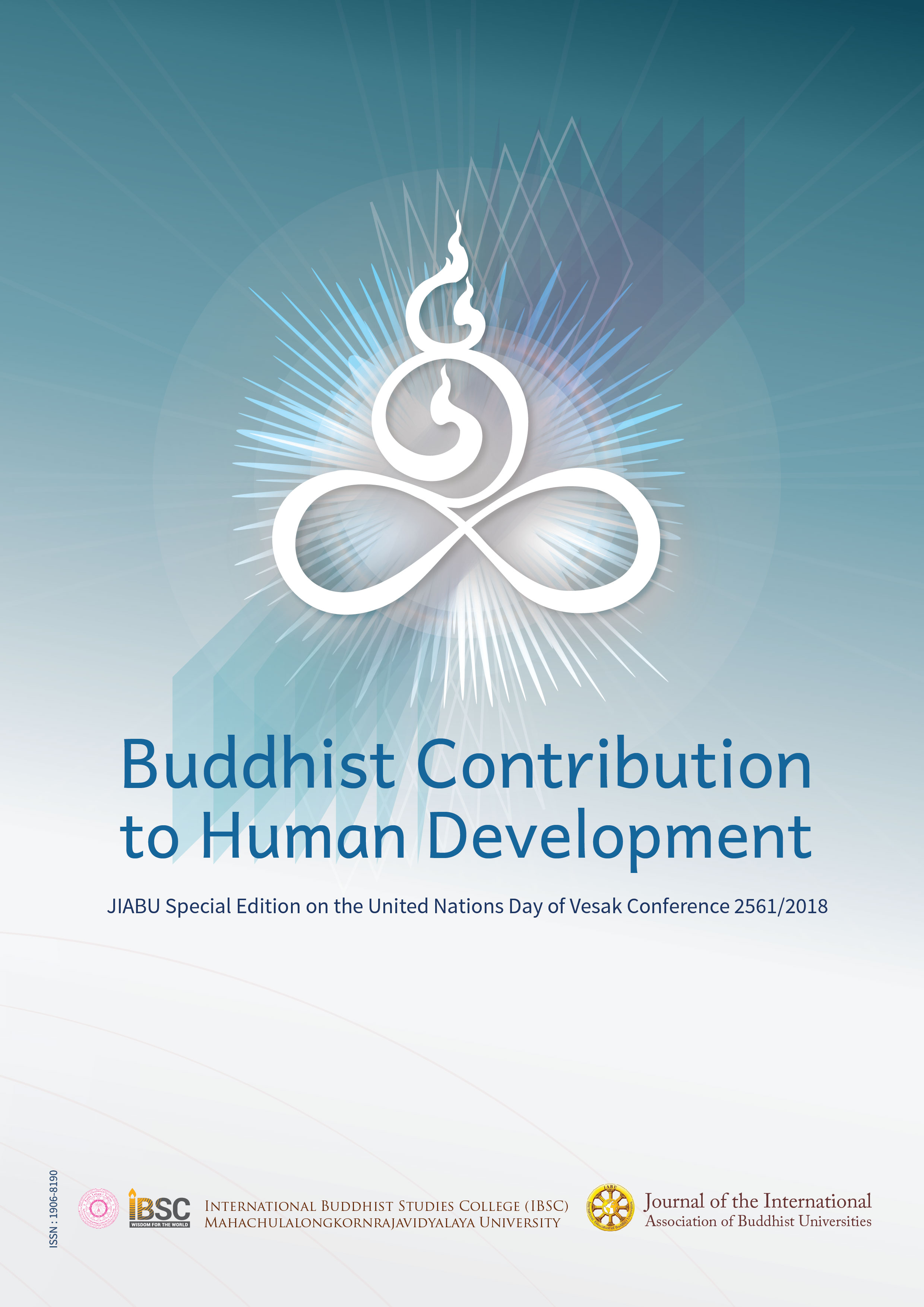The Trend of the Role of Ramañña Nikāya in the Next Decade in Mon State
Main Article Content
Abstract
This research article has three main objectives, namely: (1) to study the origin and
the development of Rãmañña Nikāya in the Mon state, (2) to study the characteristics and
the practices of Ramañña Nikāya Association, and (3) to analyze the trend of the roles of
Ramañña Nikāya in the next decade in the Mon state. It has three study attempts to explain
the main Mon Buddhism’s role in Lower Burma through an in-depth analysis of the next
decade in Mon state. This research contains five chapters: the first two are introductory
chapters describing the history of Mon Buddhism and the origin and development of Ramañña
Nikāya; the last two chapters examine the characteristics of the practices and interview the
Role of Rãmañña Nikāya that of relating to the state, Sangha education and propagation of
the religious title to the Sangha who is prompting in the next decade in Mon State. The last
chapter contains the conclusion of this research: Rãmañña Nikāya’s role in Mon society,
Mon Sangha association and Mon people in Mon State. Ten scholars of Mon Buddhism
were interviewed for the primary source in this dissertation.
The study has shown that through the assigned objective, Mon Buddhism began and
developed before Pegan, during Pegan, and after Pegan during conflicts of civil war. Based
on the results of the analysis, the study presents possible solutions to the conflict. These
periods involve various conditions based on the results of the analysis of a long history
of Ramañña Nikāya. From analyzing the characteristics and practice of Mon Buddhism
in Mon State, some characteristics and practices may differ due to the differences in the
national culture of Mon in Burma. This is because the Burmese are influenced by Mon
culture. Mon Buddhist monks also play an important role and pay more respect to the Mon
society in the Mon State. No research on Ramañña Nikāya Association in Burma has ever
been done before.
Article Details
Views and opinions expressed in the articles published by The Journal of the International Association of Buddhist Universities (JIABU), are of responsibility by such authors but not the editors and do not necessarily reflect those of the editors.
References
Bdnald K. Swearer. The Buddhist World of Southeast Asia.USA: State University of New Press, 1995.
Benedict Rogers, Burma A national at the Crossroads, London: an imprint of Ebury Publishing, 2012.
Bhikkhu Aliyesako, Bhikkhu’s Rules: a guide for laypeople. The Theravada Buddhist Monks Rules, Australia, 1999 CE.
Brahmagunabhorn, Phra (P.A. Payutto). Thai Buddhism in the Buddhist World. Thailand: Mahachulalongkornrajavidyalaya Press, B.E. 2548/ 2005. C.E.
Buddhism in Southeast Asia, Chiang Mai: 2010.
Dr. Yenbamroong Narongsak, Buddhist Monastic Life in South-East Asia, Magada University, Bodh-Gaya, 2002.
Dr: Nai Pan Hla, “A Short History Of The Mons” Part (1) The Original Homeland of the Mons (Migration), Japan: Meio University, Nago City, 2007.
Guillon, Emmanuel, The Mons: A Civilization of Southeast Asia. Bangkok, The Siam Society, Bangkok, Thailand, 1999.
Johns. Strong. The Legend Of King Asoka, A Study and Translation of the Aśokāvadāna,
Jon Fernquest, Rajadhirat’s Mask of Command: Military Leadership in Burma, (C.1348-1421), Vol.4, Issue 1, (2006).
Kalyani Inscriptions, Erected by King Dhammaceti at Pegu in 1476 A.D., Government Printing, Burma.1892.
Kanai, Lal Hazra, History of Theravāda Buddhism in South-East Asia with special reference to India and Ceylon, New Delhi, 1982.
Lanai Lal Hazra. Thailand Political History and Buddhist Cultural Influences. New Delhi: 2000.
le May Reginald, The Culture of Southeast Asia, Unwin Brother Limited, Great Britain
Mahinda Deegalle, Buddhism, Conflict and Violence in Modern Sri Lanka, London and New York, 2006.
Marie Lall and Ashley South, Education, Conflict and Identity: Non-state ethnic education regimes in Burma, March 2012.
Nai Pan Hla, The Razadarit Ayedawbon, (in Burmese version), 8th Printing, Yangon: Gangaw Myaing, 2005.
Nai Pan Hla,The Significant Role of The Mon Language and Culturr In Southeast Asia, Part I, Institute for The Study of Languages and Cultures of Asia and Africa (ILCAA), 1992.
Naing Pann Thar, Rāmañña Nikāya and Mon Sasana, Yangoon, 2016.(Myanmar Translation Book)
Niharranjan Ray, An Introduction of the Study of Theravāda Buddhism in Burma, University of Calutta, Printed in India, 1946.
Noble Ross Reat. Buddhism: A History, California: Jain Publishing, 1994.
Pakawadee & Thongchompunuch, 7th International Conference on Humanities and Social Sciences “ASEAN Challenges and Opportunities”, Mon Diasporas in Thailand and the Notions of “Home,” 2015,
Phra Maha Hansa Dhammahaso, The Chulalongkorn Journal of Buddhist Studies, vol.9, 2015, Center For Buddhist Studies Chulalongkorn University Bangkok, Thailand, 2229-1229.
Prapod Assavavirulhakarn. The Ascendancy of Theravāda
Prof. P.V. Papat S. Radhakrishnan, 2500 Years of Buddhism, India: Book House, 1959.
Prof. P.V. Papat S. Radhakrishnan, 2500 Years of Buddhism, India: Book House, 1959.
Rahula, Walpola, What the Buddha Taught, London: The Gorden Fraster Gallery limited Bedford, 1959.
Reprint Archaeological Survey of Burma, Rangoon: Superintendent, Government Printing, 1961.
Roger Bischofff, Buddhism in Myanmar A Short History, Buddhist Publication Society, Sri Lanka, 1995.
S. Sivaraksa. A Socially Engaged Buddhism, A Controversial Siamese.Bangkok: 1988.
Saya Thein “Shin Sawbu,”Journal of the Burma Research Society, 1910.
Shorto, H.L. “The 32” Myos in the Medieval Mon Kingdom.” Bulletin of the school of oriental and African Studies, University of London, Cambridge University Press,1963.
Stephen C. Berkwitz.South Asian Buddhism A Survey, New York: 2010.
The Collection of Mon Article, The journal of Burma Research Society, Rangoon, Burma.
The History of Buddhism in The Suvannabhumi Period (Burmese Version), M.A Thesis Submitted to the SPS University, Yangon, Myanmar, 2003.
The Mons: A Civilization of South-East Asia, Guilon Emmanuel, The Siam Society, Bangkok, Thailand, 1999
The Talaing Plaques on the Ananda Temple at Pagan. Epigraphica Biranica Being Lithic and Other Inscriptions of Burma 2, pt.1 (1920).
The Teaching of The Buddha (Higher Level) Volume II, DPPS, Rangoon, Burma, 2001.
The Teaching of the Buddha, (Higher Level) Volume II, DPPS, Rangoon, Burma, 2001.


